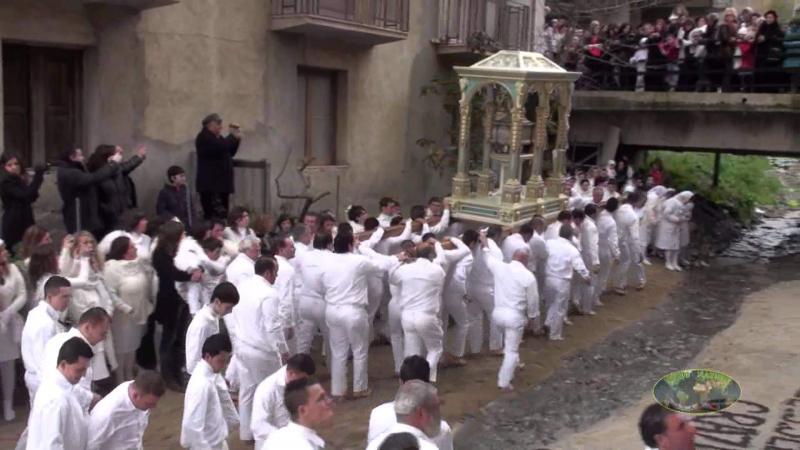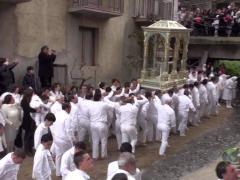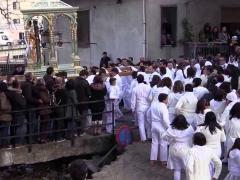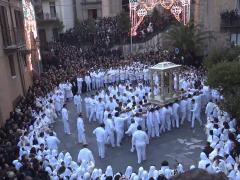Feast of the Bimartire San Sebastiano
Street View (if present)
Description
Feast of the Bimartire San Sebastiano
Property included in the Register of Intangible Heritage of Sicily (REIS)
The cult of S. Sebastiano is strongly rooted in the historical documentation, starting from 1600 the Glorious Bimartire S. Sebastiano is the Principal Patron and Protector of the Victorious City of Tortorici, his chapel was in the Church of S. Maria de Platea, while the brotherhood had its seat in the oratory of S. Sebastiano located in the Spirito Santo district.
The cult and the feast of the Saint, except for a few variables, are marked by a historical continuity in the liturgy, at least in the last four hundred years. The eras that have brought about radical changes have not substantially changed the rite, a clear sign that the reasons for the cult are rooted and rooted in the religious sentiments of the people.
Every believer recognizes himself in the Patron Saint from whom "Grace" is asked for a miracle; the vow binds the faithful to the Saint for life: "naked" St. Sebastian becomes a perpetual vow.
The long feast in honor of St. Sebastian begins on January XNUMXst with the sound of the bell and the exposure of the saint to the city.
The cult and the feast of the Saint, except for a few variables, are marked by a historical continuity in the liturgy, at least in the last four hundred years. The eras that have brought about radical changes have not substantially changed the rite, a clear sign that the reasons for the cult are rooted and rooted in the religious sentiments of the people.
Every believer recognizes himself in the Patron Saint from whom "Grace" is asked for a miracle; the vow binds the faithful to the Saint for life: "naked" St. Sebastian becomes a perpetual vow.
The long feast in honor of St. Sebastian begins on January XNUMXst with the sound of the bell and the exposure of the saint to the city.
Visit Sicilian Intangible Cultural Heritage database to learn about other intangible assets
Visit Data Maps Heritage: Set of databases of the Sicilian Cultural Heritage to know other databases (nature, baroque, archeology, material assets and much more)
----------------
Technical sheet prepared by: Region of Sicily - Department of cultural heritage and Sicilian identity - CRicd: Regional center for inventory, cataloging and documentation and Sicilian regional film library
N. Prog. 104
Well: Feast of the Bimartire San Sebastiano
Book: REI - Book of celebrations
Approval date: 21-03-2008
Category: Patronal feast
Province: Messina
Municipality: Tortorici
Local denomination: Sammastianu
Chronological News
San Sebastiano is one of the best known, venerated and loved saints in all of Sicily. The spread of his cult follows the scourge caused by the plague in Sicily which was annihilated thanks to the thaumaturgical intervention of the Saint. In fact, in Palermo, after 1575, the Senate decided that a solemn feast would be celebrated in honor of the saint, during which the statue of San Sebastiano and that of San Rocco met, both carried in procession by groups of faithful to the four city songs: in this intersection the two statues used to meet and bow in the form of greeting.
The cult of the saint is also widespread in the province of Syracuse, starting from the town of Melilli, especially following the earthquake of 1693: at the end of April every year, a solemn event in honor of the saint is celebrated by the arrival of the "naked“, Or the devoted pilgrims, who came on foot from all over Sicily, wearing only a fig leaf, symbolically identifying themselves with Adam, the initiator of mankind.
Other important and solemn celebrations in honor of the saint are still held today in Francofonte, Palazzolo Acreide, Acireale, Avola, Buscemi, Barcellona, Cerami, Ferla, Gaggi Graniti, Limina, Maniace, Mistretta, Mongiuffi Melia and above all in Tortorici. Here takes place one of the longest and most articulated festivals in Sicily, with celebrations that take place over about twenty days, from 10 January to the end of the month.
The origins of the festival in Tortorici date back to the miraculous discovery of the relics of San Sebastiano and the bell of the church of Santa Maria during the flood that hit the town in 1682 (u flood): an impetuous torrent of mud poured through the streets of the town but only two pilgrims from Rome with the relics of San Sebastiano and the bell were held back by a mysterious force near the Calagni stream and from that moment the Saint was proclaimed " Patron of Tortorici ".
Recurrence: Annual
Date: January 20
Occasion: Celebrations in honor of San Sebastiano in Tortorici
Function: Patronal, devotional and propitiatory
Actors: Civil (the Mayor) and religious authorities (bishop and parish priest), i dealers (bearers of the keys of the city), the "nuri"(Faithful who have made a vow) bearers of the launch of the Saint, the brotherhoods, the women dressed in white who precede the simulacrum.
Participants: Local community of the faithful, tourists
Description
The long feast in honor of San Sebastiano begins on January 10 with the sound of the bell and the exposure of the saint to the city. The event represents a concentration of ritual practices, traditions and manifestations of popular religiosity: prayers, evocative and purifying fires, processions, firecrackers, creation of sacred spaces bordered by magical trees, processions of laurel and hawthorn trees, devotees who by vow they dress in white and lead the Saint barefoot, even through the icy waters of all the streets of the town, until late in the evening; devotees who make the Saint run to the sound of the fanfare; devotees who eat and drink wine along the way to face the cold and fatigue. During this period of celebration, the blessing and distribution of loaves also takes place, "panitti the Sammastianus"; the function of forgiveness takes place, "u pirdunu”, As if to apologize for the excesses committed on feast days, with the distribution to the faithful of cotton fragments considered relics of the Saint. Historical episodes are recalled, "in fuiutina da vara”, The attempt to steal the vara by a community devoted to San Sebastiano, perhaps that of Melilli itself.
The program of the celebrations includes several main phases spread over several days: the "party of bura”, Which consists of a night torchlight procession through the streets of the town, during which the faithful carrying bright bundles of ampelodesm inflorescences, a plant sacred to the dead, which are distributed to all present on the portal of the Chiesa della Matrice. The procession, accompanied by the sound of a drum, recalls the search and discovery, by Christians, of the body of the saint still alive, after having suffered the torture of arrows. Both the elders of the village participate in the torchlight procession, who carry torches every year by vote, and the young people, who at the end of the path jump and challenge a large purifying bonfire, which is lit and fed by the remains of the bundles carried in procession and collected in the churchyard. of the church. Even today, the elders of Tortorici, men and women, lead a torch in procession by vote.
On the Sunday before the Feast, in the morning, upon returning from the procession of Sant'Antonio Abate, the devotees begin the Parade of the Laurel along the streets of the city to the Church of Santa Maria Assunta, where the laurel or holly lead, thus creating an improvised magical wood. The laurel recalls the sacred wood in Adonis where Saint Sebastian, tied naked to a tree, was shot at by the arrows of the ferocious Mauritanian archers.
The feast always falls on January 20 and the devotees who have a vow to dissolve, go "naked" to the Saint and as a penitential sign they dress in white with shirt and trousers, a handkerchief folded like a triangle around the waist and bare feet. The women, barefoot, wear white shirts and skirts, the handkerchief covers the head and precede and follow, in the procession or in the quest, the Saint.
The religious rite is celebrated in the Church of Santa Maria Assunta, with the participation of the local authorities, preceded by dealers who go to the church delivering the keys to the city as a sign of homage to the saint. At noon the procession begins through the streets of the city which is opened by three altar boys dressed in white and red tunic leading a processional cross; follows the parish priest, the "launch" supported by at least sixteen pruners, and all the other men, members of the "nuri", Dressed in white, barefoot, about a hundred. They are followed by women and children all dressed in white. The musical band awaits the procession outside the church and precedes it for the first parts of the procession. The whole procession of faithful follows in disorder. At the sound of the Bell and the cry "thanks San Bastiano, thanks!”The long procession starts. The artistic "Items"Is carried only by"nuri”, As a sign of privilege and penitential obligation. During the long journey, the bearers of the vara alternate steps with dances, causing the fercolo dance in the crowd. For this reason the replacement of the carriers takes place continuously, as their function is particularly tiring given the weight of the entire ferculum. The first stage of the Procession is in Calagni River where the devotees stop the vara invoking grace. After the break, the "begging”, That is the offering and the Saint is carried through the streets of the city returning to the Church of San Nicolò where it remains until the eighth.
The feast in honor of the patron saint is repeated on the Sunday closest to 9 May.
REFERENCES
Buttitta, Ignatius. 1992. Laurel festivals in Sicily, Palermo: Ignazio Buttitta Foundation.
Costa, Horace. 1989. Popular festivals in the Messina area, Messina: Falcone Library Archive.
Falcone, Nino. 1977. Religious feasts of the Nebrodi, Marina di Patti (ME): Pungitopo Editions.
Francina, Sebastian. 1982. Tortorici - Popular traditions, Milazzo: Spes Editions.
Pitre, Giuseppe. 1881. Sicilian folk shows and festivals, Palermo: Pedone-Lauriel.
Pitre, Giuseppe. 1886. Trees and plants in Sicilian customs and popular beliefs, Palermo: Archive for the Study of Popular Traditions, v. V, pp. 119-128 and 165-196.
Pitre, Giuseppe. 1889. Uses and customs, beliefs and prejudices of the Sicilian people, Palermo: Pedone-Lauriel.
Pitre, Giuseppe. 1900, Patronal festivals in Sicily, Turin-Palermo Clausen.
Sitography
Tourism portal of the Sicilian Region Celebrations in honor of San Sebastiano [last consultation 27-04-2016]
Filmography
Celebrations in honor of San Sebastiano in Tortorici.
The film video document in DVD on the feast of San Sebastiano (87 SBCA ME // 0002)
Discography
Footnotes
This festival was also called the gift party, since the devotees to the Saint gave gifts to the members of the deputation of the feast pro San Sebastiano, which was constituted every year, and which collected enormous sums of money.
Card Author: Chiara Dell'Utri
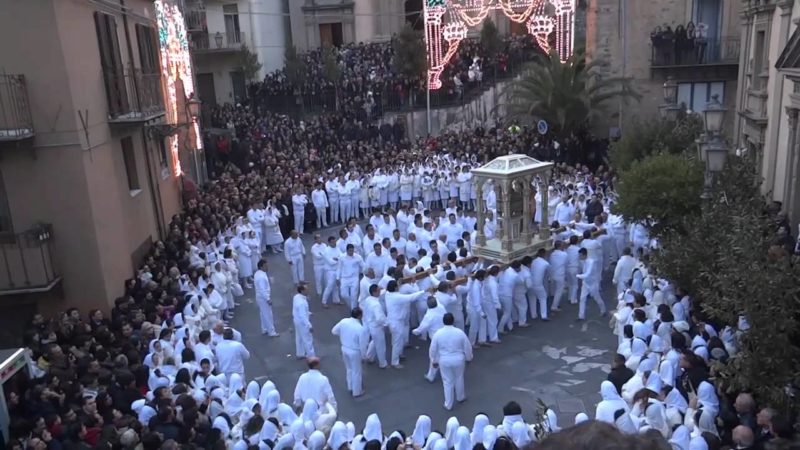
Go to Google Maps
Send a notice to the publisher
[contact-form-7 id="18385"]

